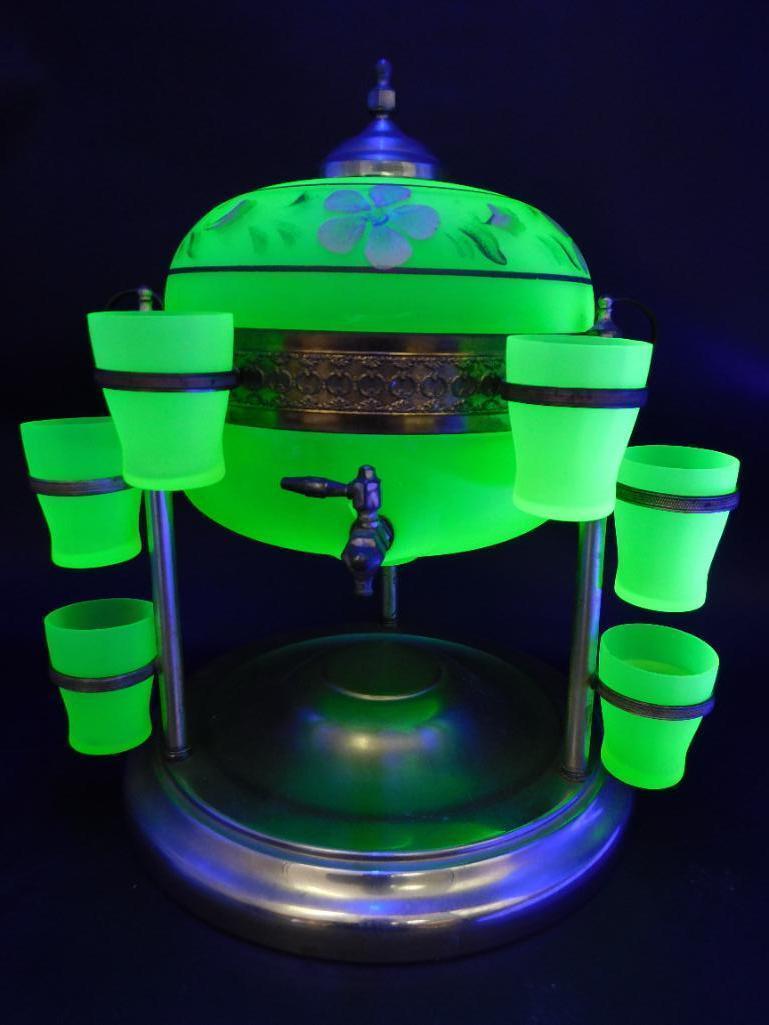
The Sparkly Backstory of Uranium Glass
Share
Picture this: it’s the early 19th century. Fashion is frilly. The Industrial revolution is changing everything. And somewhere in Bohemia (that magical land of glass‑making), artisans begin experimenting. They toss a little uranium oxide into their molten glass, perhaps thinking, What’s the worst that could happen?
Turns out, what they got was absolutely luminous. The glass ends up with a yellow‑green tint—and later, with UV light, an eerie green glow. Suddenly, simple vessels are bathed in an otherworldly radiance.
Name Games: Vaseline, Canary, Custard & Friends
Because what’s a novel kind of glass without a few thousand nicknames?
-
“Uranium glass” is the all‑purpose term. If it has uranium oxide, it counts.
-
“Vaseline glass” refers especially to transparent yellow‑to‑yellow‑green glass. Why Vaseline? Maybe the sheen, maybe the oily yellow color. Either way, vivid.
-
“Canary glass” is an older name (think mid‑1800s) for similar yellow‑tinted glass. Birds not involved.
-
“Custard glass” and “Burmese glass” are more opaque cousins; they mix in other additives and play with opacity. Burmese glass, in particular, used uranium plus a tint of gold to yield that soft yellow glow.
Golden Age, War, & Glow
Rise
By the mid‑1800s, uranium glass is becoming kind of a thing. European glasshouses (especially in Bohemia) crank out pieces. Artists and manufacturers experiment with how much uranium, what other colorants to add, how to adjust transparency. The glass becomes a decorative hallmark—vases, bowls, candlesticks.
Peak
From about the 1880s to the 1920s, this stuff is everywhere. It’s stylish. It’s modern. It’s a conversation piece. Especially appealing because it can glow under UV light (though early on people cared more about its color in daylight and candlelight than about glowing under lamps no one had yet).
Pause for War
Then World War II rolls around, and uranium ceases to be just a pretty colorant. It becomes strategic material. Glassmakers lose access; civilian production is restricted.
After the War
Post‑war, production resumes in some places. Sometimes using depleted uranium instead of natural uranium. The volumes never reach pre‑war heights. By the later 20th century, it’s mostly decorative or collectible pieces rather than everyday glassware.
Quirky Facts & Collector Attractions
-
Even ancient Romans got in on it: a mosaic from around 79 AD in a villa near Naples was found to contain yellow glass with about 1% uranium oxide. Uranium glass is older than most people think.
-
Under UV (black light), uranium glass glows bright green. That side effect wasn’t the primary reason initially, but today it’s one of the coolest bits of the story.
-
The uranium content is small—often around 2% by weight in many pieces; in some early ones even higher. For most uses, the radiation from intact uranium glass is very low.
The Present: Legacy & Glow
Nowadays, uranium glass is cherished by collectors more than anything else. Antique shops, flea markets, museums, people’s grandmother’s cabinets—places where these gems survive. Some modern art glass makers still produce glowing glass using regulated uranium, mostly decorative.
Also: people love showing them off with UV lights, black lights, dramatic lamp setups. Because there’s something magical about having an object in your house that glows like a radioactive Kryptonite. (Don’t worry—mostly harmless.)
A Light‑hearted Moral
So what’s the takeaway? Uranium glass reminds us to pay attention to the weirdness in everyday things. A bowl, a vase, a juice glass—laced with a little element from deep in the earth—turns into something enchanting. And it shows up in history, in science, in art, sometimes in war, and always with a bit of flash.
Next time you see a yellow‑green vase peeking out of dusty shelves, shine a blacklight. You just might find your own glowing legacy.
